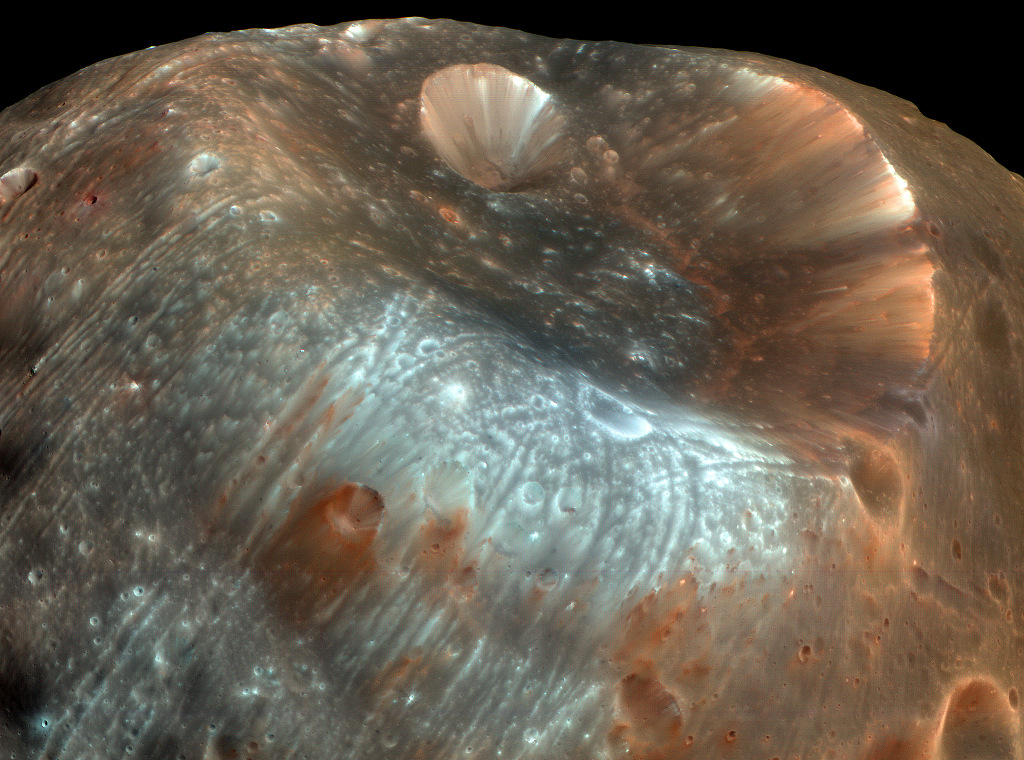안녕하세요!
디지탈노다지입니다.
미국 NASA에서 제공하는 오늘의 우주 사진을 공유합니다.
어떤 우주의 모습을 비춰줄까요?
우선, 사진부터 감상하시죠! 이 멋진 사진의 제목은 Stickney Crater 입니다.
NASA에서 공식적으로 제공한 설명을 보시죠. Stickney Crater, the largest crater on the martian moon Phobos, is named for Chloe Angeline Stickney Hall, mathematician and wife of astronomer Asaph Hall. Asaph Hall discovered both the Red Planet's moons in 1877. Over 9 kilometers across, Stickney is nearly half the diameter of Phobos itself, so large that the impact that blasted out the crater likely came close to shattering the tiny moon. This enhanced-color image of Stickney and surroundings was recorded by the HiRISE camera onboard the Mars Reconnaissance Orbiter as it passed within some six thousand kilometers of Phobos in March of 2008. Even though the surface gravity of asteroid-like Phobos is less than 1/1000th Earth's gravity, streaks suggest loose material slid down inside the crater walls over time. Light bluish regions near the crater's rim could indicate a relatively freshly exposed surface. The origin of the curious grooves along the surface is mysterious but may be related to tidal stresses experienced by close-orbiting Phobos or the crater-forming impact itself. 화성의 위성 포보스에서 가장 큰 분화구인 스틱니 크레이터는 수학자이자 천문학자인 아삽 홀의 아내인 클로이 안젤린 스틱니 홀의 이름을 따서 지어졌다. 아삽 홀은 1877년에 붉은 행성의 두 위성을 발견했다. 지름이 9킬로미터가 넘는 스티크니는 포보스 자체 지름의 거의 절반 정도로 크레이터를 폭파시킨 충격이 작은 달을 산산조각 낼 정도로 컸을 것이다. 스틱니와 주변의 이 강화된 색상의 이미지는 2008년 3월 화성 정찰 궤도선에 탑재된 HiRISE 카메라가 포보스에서 약 6천 킬로미터 이내를 통과할 때 기록했습니다. 소행성처럼 생긴 포보스의 표면 중력은 지구 중력의 1/1000 미만이지만, 줄무늬는 시간이 지남에 따라 느슨한 물질이 분화구 벽 안으로 미끄러져 내려갔음을 시사한다. 분화구 가장자리 근처의 옅은 푸르스름한 지역은 상대적으로 갓 노출된 표면을 나타낼 수 있다. 표면을 따라 있는 기이한 홈의 기원은 신비롭지만, 가까운 궤도를 도는 포보스나 분화구를 형성하는 충돌 자체가 경험하는 조석 응력과 관련이 있을 수 있다. 우주의 다양한 모습은 아름답습니다~
그리고 광활하며 거대합니다. 형형색색 변화하며 살아있는 듯한 느낌을 주네요~ 가볼 수는 없지만 이렇게 사진으로 볼 수 있어서 좋네요!
디지탈노다지는 더 좋은 사진과 함께 돌아오겠습니다,
남은 하루도 행복하세요~ 
'자동화정보' 카테고리의 다른 글
| Stars, Dust and Nebula in NGC 6559(2023-07-10)NASA 우주사진 (0) | 2023.07.10 |
|---|---|
| Doomed Star Eta Carinae(2023-07-09)NASA 우주사진 (0) | 2023.07.09 |
| The Double Cluster in Perseus(2023-07-07)NASA 우주사진 (0) | 2023.07.07 |
| Fireworks vs Supermoon(2023-07-06)NASA 우주사진 (0) | 2023.07.06 |
| A Map of the Observable Universe(2023-07-05)NASA 우주사진 (0) | 2023.07.05 |